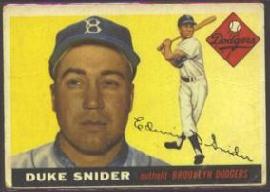






 |  |  |  |  |  |  |
 |

|
|
In 1949 he came into his own, hitting 23 home runs accompanied with 92 runs batted in, also helping the Dodgers break into the World Series. Snider also saw his average rise from .244 to a respectable .289.
From 1947 to 1956, Brooklyn ruled the National League. They benefited greatly from a large network of minor league teams created by Branch Rickey in the early 40's. It is here when the system called the "Dodger Way" of teaching fundamentals took root. From that large network of teams, a number of young talented players began to blossom at the same time: Snider, Hodges, Erskine, Branca, Labine, Furillo, Campanella, Don Newcombe, Joe Black and Jim Gilliam.
By 1949, Snider, as he matured, became the triggerman in a powerladen line-up which boasted the likes of Jackie Robinson, Pee Wee Reese, Roy Campanella, Gil Hodges and Carl Furillo. Often compared favorably with 2 other NY center fielders, Mickey Mantle and Willie Mays, he was the reigning "Dook" of Flatbush. Usually batting third in the line-up, Snider earned his sobriquet by putting up some tremendous offensive numbers on the board: He hit 40 or more home runs in five consecutive seasons (1953-57) and averaged 42 home runs, 124 RBI's, 123 runs and a .320 batting average between 1953-1956. He led the league in runs scored, home runs and RBI's in separate seasons. He appeared in six post-seasons with the Dodgers (1949, 1952-53, 1955-56, 1959), facing the New York Yankees in the first five and the Chicago White Sox in the final. The Dodgers won the World Series in 1955 and 1959.
Snider's career numbers took a dip when the team moved to Los Angeles in 1958. Coupled with an aching knee and a 440 foot right field fence at the cavernous Colosseum, Snider hit only 15 home runs in 1958 as he entered the "decline" phase of his career. Injuries and age would eventually play a role in reducing Snider to part time status by 1961. In 1962, when the Dodgers led the NL for most of the season only to find themselves tied with the hated Giants at the season's end, it was he and 3d base coach Leo Durocher who reportedly pleaded with Manager Walter Alston to bring Hall of Famer pitcher (and Cy Young award winner that year) Don Drysdale into the 9th inning of the 3rd and deciding play-off game. Instead, Alston brought in Stan Williams in relief of a tiring Eddie Roebuck. A 4-2 lead turned into a 6-4 loss as the Giants rallied to win the pennant. For his trouble, Snider was then cast off to the Mets. It is said that his roommate, Don Drysdale, broke down and cried when he got the news of Snider's departure.
Snider also played with Giants. He retired at the end of the 1964 season. In 18-year career, he batted .295 with 407 home runs and 1333 RBI in 2143 games. Snider went on to become a popular and respected play-by-play announcer for the Montreal Expos from 1973 to 1986.
Duke Snider was selected to the Baseball Hall of Fame in 1980.
The book Carl Erskine's Tales from the Dodgers Dugout: Extra Innings (2004) includes short stories from former Dodger pitcher Carl Erskine. Snider is prominent in many of these stories. In 1981 Terry Cashman in his nostalgic song about baseball in the 1950's relased "Willie, Mickey and The Duke" about the three center fielders of that era in New York. (The others of course being Willie Mays and Mickey Mantle)It has been released and rewritten for speciffic teams many times since then.
8-time All-Star (1950-56, 1963)
6-time Top 10 MVP 1950: 9th 1952: 8th 1953: 3rd 1954: 4th 1955: 2nd 1956: 10th.
.540 Slugging Percentage (36th all-time)
.919 OPS (50th all-time)
3,865 Total Bases (84th all-time)
407 Home Runs (40th all-time)
1,333 RBI (75th all-time)
1,481 Runs Created (71st all-time)
850 Extra-Base Hits (62nd all-time)
17.6 At Bats per Home Run (60th all-time)
Los Angeles Dodgers Career Leader in Home Runs (389), RBI (1,271), Strikeouts (1,123) and Extra-Base Hits (814)
Hold Los Angeles Dodgers Single-Season record for most Intentional Walks (26 in 1956)
Only player to hit four home runs (or more) in two different WS (1952, 1955)
In 1999, he ranked number 84 on The Sporting News' list of the 100 Greatest Baseball Players, and was a nominee for the Major League Baseball All-Century Team

 |  |  |  |  |  |  |